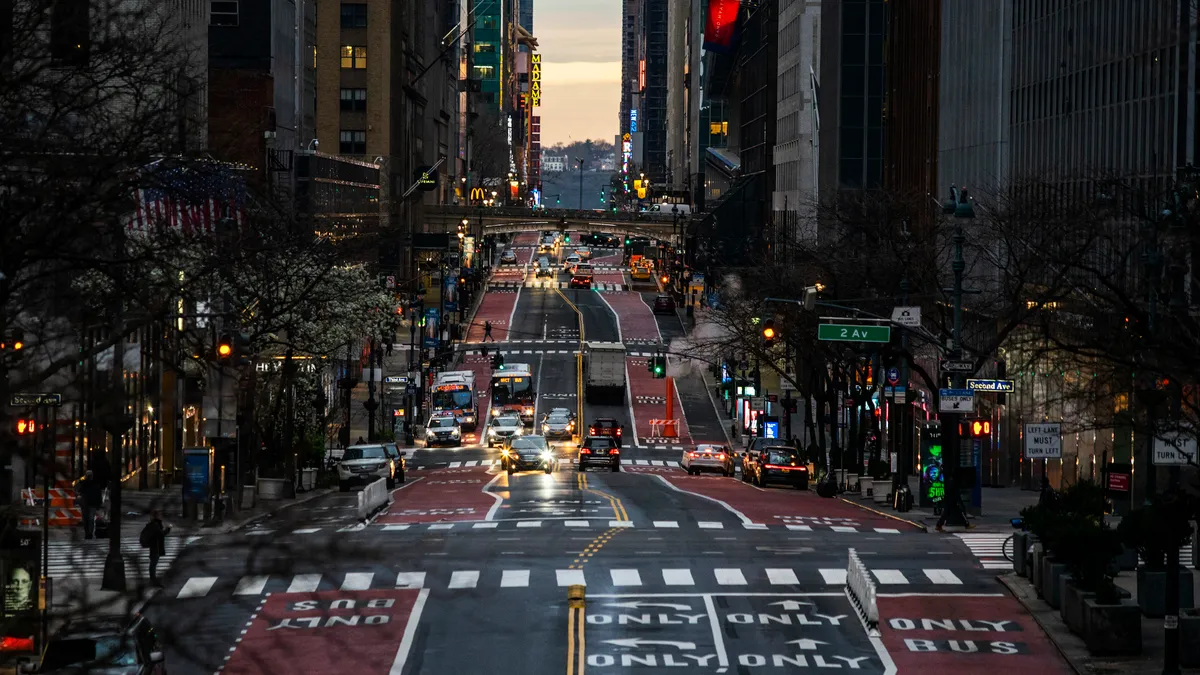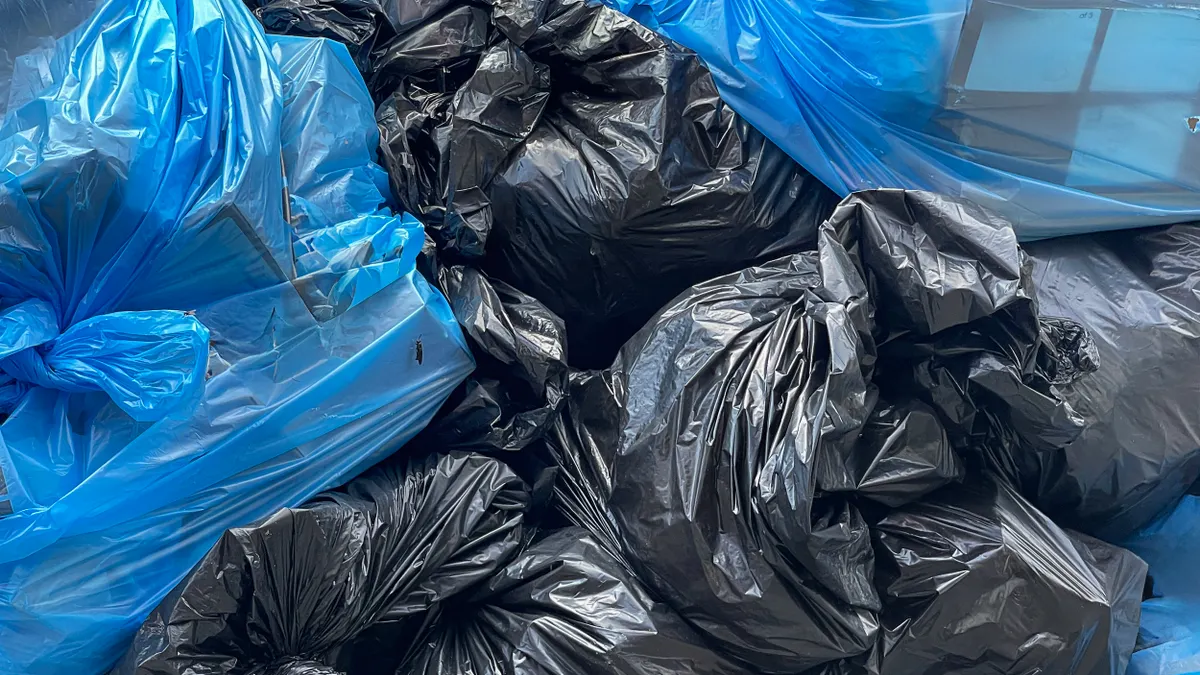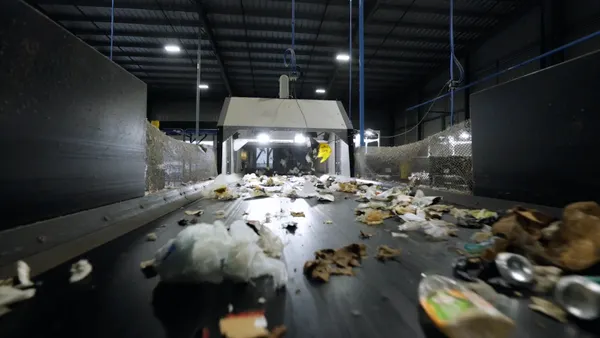Cut commercial waste vehicle traffic in half. Spur investment in new collection and recycling infrastructure. Boost recycling and organics diversion rates. Improve labor standards.
New York City has lofty goals for the waste zone system it’s about to launch next year, after nearly a decade of discussion. And the companies vying for the coveted 10-year contracts to collect commercial waste and recyclables within 20 specific areas will have a lot riding on the outcome.
"You’re going to have best-in-class carriers that are awarded these zones, and there's reputational risks as well if they don't facilitate those services,” said Gregory Lettieri, CEO of bidder Recycle Track Systems.
The estimated 100,000 customers these companies will be servicing are likely in for an eventful transition period over the next couple of years as well. The city’s Department of Sanitation says it is ramping up hiring for new staff to help with education, outreach and customer service.
"I think there really needs to be a concerted effort now to start to build in the minds of the business community that this is happening,” said New York City Council Member Sandy Nurse, chair of the council’s sanitation committee. "It's been a long time since the public has had major conversations about it."
Supporters point to positive outcomes of a preceding system in Los Angeles, known as recycLA, as a sign of what’s possible. But veterans of that system’s rollout say its beginnings were anything but smooth. The program’s launch in 2017 saw a spike in service complaints, thousands more customers than anticipated, lawsuits by property owners and more.
"Seven years of planning — that was nothing compared to six months of hell,” said Dan Meyers, manager of the recycLA franchise program for LA Sanitation & Environment, or LASAN, during a panel at WasteExpo in May. “It's not just changing one service provider to another. It was about establishing a whole new system.”
New York will need to learn from Los Angeles, industry stakeholders say, to avoid a similar launch experience in the five boroughs over the coming years.

The recycLA story
Like New York, Los Angeles previously had a permitting system for commercial waste haulers before deciding that it needed to do more to achieve its sustainability goals.
Los Angeles had an estimated 144 permitted haulers prior to the transition, but only 31 of them performed regular commercial collections, and about 15 controlled the vast majority of commercial business. Ultimately, seven haulers were awarded contracts across 11 different zones, affecting an estimated 65,000 accounts — including certain multifamily buildings.
While Recology exited the Los Angeles market during this period, large existing players such as WM, Republic Services and Athens Services solidified their presence with contracts. Athens further expanded its base earlier this year by acquiring CalMet Services, another recycLA zone contract holder.
According to Meyers, the intention was for no hauler to get more than 49% of the system and to preserve a place for smaller companies. One way LASAN did this was by creating three smaller zones near the municipally owned Central LA Recycling and Transfer Station so companies could utilize that site rather than go to their competitors’ facilities. This ended up working out as planned in the bid process, he said.
During the peak of recycLA’s issues, around December 2017, the city saw 6,000 service complaints. LASAN now reports a 99.9% rate for on-time collection, but bad memories remain.
“[Complaints] dropped off dramatically and almost immediately at the end of transition,” said Meyers. But "that six months really put us back in the eyes of our customers and their trust in the system, and it's taken us years" to recover, he said.
The system also experienced legal challenges, at least one of which is still winding through the court system — albeit unsuccessfully. Other changes since the zone system launched include an updated settlement agreement with haulers that LASAN signed in 2019 and the pandemic, the effects of which have slowed down the introduction of organics collection.
On a more positive note, city officials point to investments from haulers in hundreds of new “clean fuel” trucks on the streets, $160 million worth of infrastructure projects and $1.78 million in funding for food rescue and reuse programs as signs of clear progress. As for the system’s broader goal to reduce waste disposal, it’s too soon to tell.
RecycLA haulers are contractually obligated to reduce landfill-bound waste 65% by 2025 (from a 2019 baseline) at risk of liquidated damages in the future. No haulers hit their targets in 2019, and Athens was the only one to meet its target in 2020. LASAN says 2021 data will be released in the coming weeks.
On the labor side, workers have reportedly seen conditions improve due to contract requirements about facility standards, living wage law compliance, a hotline for employee complaints and other provisions. While it’s unclear whether unionization rates have changed substantially, Teamsters Local 396 — which represents workers at some recycLA companies — said working standards have generally improved and the union recently touted a “historic” labor peace agreement with Athens as a result of the program.

The vision for New York
In New York, the Los Angeles system looms large, for better and for worse, but it also doesn’t serve as a perfect comparison. For example, New York’s layout often requires more manual labor to collect mountains of bags at the curb while Los Angeles has far more containers that can be accessed in alleys or parking lots.
Local observers say New York’s estimate that at least 90 haulers currently operate in the commercial waste market is long outdated. Only 50 companies submitted initial bids, and a much smaller number of them currently control the majority of market share. DSNY says it will ensure competition by awarding no more than one citywide contract for containerized waste and no more than 15 zone contracts to any one company. Each hauler will pay an annual franchise fee of more than $107,000.
Unlike the recycLA system, New York’s contracts do not require a specific level of infrastructure investment. Instead, the city has encouraged such proposals and will factor them into its bid decisions. Some are skeptical of how that will play out from a cost standpoint.
"Commercial customers in New York are in for a rude awakening in that we can provide all these services, but we have to charge for that,” said Will Flower, vice president of corporate and public affairs at Winters Bros. Waste Systems, during the WasteExpo session. “There's excessive government environmental regulation in New York City and there's a limited return.”
While Long Island-based Winters Bros. paid to get a local hauling license and submitted an initial bid, the company hasn’t confirmed whether it submitted a final bid this summer.
Those who did submit bids say they have plenty of plans to invest in the system if they win contracts. New York is known for having an older recycling infrastructure, aside from the modern Sims Municipal Recycling MRF that processes residential material, and this could be a way to level up.
Mr. T Carting, which intends to merge with Boro-Wide Recycling in the event of a successful bid, is eyeing multiple projects. They could include a rail-based transfer station, an updated MRF (following the combination of two existing operations) that could process up to 150,000 tons per year and an organics recycling facility (ORF) to prepare up to 90,000 tons of material for processing per year. Mr. T previously announced a 36.4% diversion rate for 2021, with a goal to hit 45% by 2027.
"There’s not a lot of organics processing in the city, but there's a lot of organics processing around the city,” said Mr. T President Tom Toscano, citing active or upcoming regional facilities. "Opening an ORF, I think, would be extremely attractive.”
On the fleet side, Toscano said he’s already changed out his trucks over the last six-plus years to meet local emissions standards.
Domenic Monopoli, CEO of Filco Carting, is in the midst of his own fleet upgrade, and that will include retrofitting additional trucks to collect organics, he said. While Filco stopped a recycling processing operation around 2016, when paper markets were tight, Monopoli said he also could potentially launch a new facility to get back into that business.
Lettieri of RTS said he’s confident the system will lead to higher recycling rates, likely with some enforcement from the city. He said his company is ready from a logistics and sustainability technology standpoint and views zoning as “an opportunity to showcase this at a bigger scale within New York.”
Dominic Susino, chief financial officer of American Recycling, pointed to his company’s aspirations of converting an existing transfer station into a rail-served facility with solar panels on the roof. The concept has run into community pushback and could require a legislative update from the New York City Council to work around a 2018 transfer station capacity law.
The zone system could also result in a potential shift of material going to existing regional facilities. For example, WM submitted its sizable network of transfer stations, organics pre-processing sites and MRF in the New York metro area as being available to accept material from haulers. The company previously declined to comment on whether it bid for its own hauling contracts.
Another facility, among many, that has caught the attention of New York waste industry participants, is a 166-ton-per day organics depackaging project from Denali Water Solutions that would be located at a site leased from Waste Connections in the Bronx. Denali confirmed this project is still planned.
As for the potential labor outcomes, advocates point to a safety task force (including representatives from the Solid Waste Association of North America, the Teamsters and others) as a positive first step from the law. New York is seeing a resurgence of organizing activity in other sectors, but it’s unknown whether this could lead to higher unionization rates for waste workers.
“Companies will have to actually have health and safety protections for their workers and better conditions for their workforce,” said Maritza Silva-Farrell, executive director of the nonprofit Alliance for a Greater New York. Silva-Farrell said she’d be surprised if more workers don’t consider organizing as a result. “We do know that the best way to enforce those things are through a unionized effort.”
The Teamsters organization, which was a key player in the Transform Don’t Trash coalition led by the nonprofit and others, said it’s too soon to know.
"It's possible that our membership can grow if some of the smaller companies are acquired by the others, but we're just going to be extremely happy to see the companies that we do represent are not going to have to worry about players coming into the market completely undermining them,” said Bernadette Kelly, a trustee on the Teamsters Joint Council 16 executive board and member of the safety task force. "That should at least give our membership some security and stability."

Looking ahead
As bidders await contract decisions in the coming months, two key themes often come up in discussions about the future: M&A and implementation planning.
The New York City market has been an exception to the wave of consolidation happening across the U.S. waste and recycling industry due to the uncertainty around zoning and longer-term factors.
“I think that New York is a uniquely challenging place to do business, and that is why, even pre-COVID, it was not dominated by large national companies,” said SWANA CEO David Biderman earlier in the year. “I think the existence of a rate cap puts a ceiling on profitability that national companies take into account when determining where to allocate capital.”
Biderman, among others, anticipates that any M&A moves won’t occur until after bids are awarded — as has been common in other franchise markets around the country.
“The bigger guys, I don’t think they start to roll up any acquisitions until after,” said American Recycling’s Susino, noting valuations could range greatly depending on contract outcomes.
DSNY will have to approve any acquisitions involving zone awardees. The agency reserves the right to add new carters into a zone if competition is lessened, but some have questioned if a new hauler could adequately compete with others that have already won over customers.
Meyers said LASAN intentionally started with one hauler per zone because consolidation that reduces competition was viewed as inevitable. Speaking about New York, he said, “if you start off with three, I think you're going to wind up dwindling down fairly quickly.”
For the haulers that remain, figuring out the best way to implement zones while also maintaining business in the existing system will be challenging. Los Angeles saw some “rogue” haulers without contracts attempt to continue service in the early months. While some companies that didn’t win contracts still perform roll-off work in the area, others have set their sights on neighboring cities — including some, such as Glendale, that have since pursued their own franchise systems.
Whenever the process kicks off in New York next year, opinions vary greatly about how best to roll out service across 20 zones and five boroughs.
"I personally think they're going to force guys out of business if they don't do it all at once,” said Monopoli.
Multiple sources pointed out the potential problems a gradual rollout could create: a company could see its existing business evaporate in an area where it didn’t win a contract while trying to maintain a workforce for weeks or months until its own zone is activated.
"It would be a lot of ambiguity for the employees, and the employees would just naturally jump to safe haven, and that's kind of a fear that I have for the city,” said Lettieri.
DSNY has plans to assist displaced workers, but the process could be complex.
Some think Staten Island is the best place to start implementation, given its contained environment and smaller number of zones relative to the other four boroughs. Manhattan could be the best place or the worst place to start, depending on who you ask.
"Manhattan, especially Midtown, would probably be last. Because those are the famous zones where you have 18 to 20 carters,” said Toscano. “You go down to three, you're going to have a lot of disruption."
Other uniquely complicated factors for Manhattan include the possible implementation of a congestion pricing program in certain areas, which the National Waste & Recycling Association is seeking an exemption from for haulers.
Kelly said the Teamsters are confident in the city’s ability to roll out the program effectively, in part because the career DSNY staff behind this program stayed on during a recent change in mayoral and agency leadership.
"We understand that there are going to be potential disruptions. We're prepared to handle that and make sure it goes as smoothly as possible,” said Kelly. "As long as we keep our relationships with the employers in a way that's going to benefit our members, we're ready to roll."
Nurse said she plans to “hold DSNY’s feet to the fire” via her committee position to ensure the work is done effectively and inclusively.
“The city needs to do a lot of work now to communicate the benefits and the importance of this reform early and quickly and in as many languages as possible,” said Nurse. "We always wait ‘til the 11th hour to really put in some resources to tell people, and then of course we're surprised when people are upset about it."
DSNY is budgeted for 27 civilian staff and 10 uniformed staff during the current fiscal year to work on customer service, education and outreach. DSNY said its Bureau of Commercial Waste currently has 17 civilian staff. According to the agency, there will be a “dedicated team of 10 permanent outreach staff engaged in educating New Yorkers,” on the commercial waste zone system and it is currently soliciting bids for an outside contractor to provide “approximately 30 additional field staff during the two years phased-transition period.”
As for when and how the transition process may unfold, the agency says it’s too soon to know.
“DSNY will release the transition timeline and details of the phased approach through a rulemaking process that will occur after the RFP evaluation has concluded,” said Press Secretary Vincent Gragnani via email. “We expect the transition process to begin in mid-2023, however this is dependent on the timeline for the RFP review, and contract negotiation and registration processes.”



















